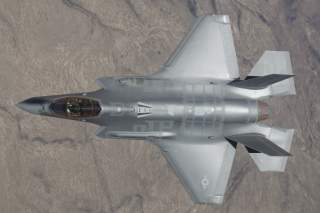F-35 Is Dead: Europe Wants to Build the Most Advanced Stealth Fighter Ever
Can they pull it off?
Key Point: There have been numerous weapons that are the fruits of European cooperation, such as the British-German-Italian Tornado jet, or the Franco-German HOT anti-tank missile. Yet Britain, Germany, Italy and France have their individual main battle tanks.
Ever since the guns fell silent in 1945, Europe has always been in third place in the global arms race.
Nations such as Britain, France and Sweden could devise weapons of clever and innovative design. But when it came to weapons technology, the innovation came from the United States and the Soviet Union/Russia, who were willing to spend vast amounts of treasure on military research and development.
But is a new generation of weapons coming that will put Europe on a par with America and Russia?
At the Paris Air Show last week, a model of the Future Air Combat System drew crowds. A sixth-generation fighter of Franco-German-Spanish parentage (though of largely French descent), it might be Europe’s counterpart to whatever manned jets—or drones—succeed the U.S. fifth-generation U.S. F-22 and F-35 stealth fighters, or Russia’s Su-57.
FCAS is built around futuristic concepts: stealth configuration, long-range missiles and—most importantly—manned-unmanned teaming. Like a stealth queen, the fighter will be attended by a retinue of drones that will do much of the dirty work of fighting, scouting and taking the brunt of enemy fire. The United States is working on the same concept with its Loyal Wingman program and the XQ-58 drone, a mini-F-35 lookalike that will work with manned aircraft like a pack of hunting dogs and their master.
Not to be outdone by its Continental cousins from whom it is separating, Britain is developing its own sixth-generation fighter. The laser-armed Tempest is envisioned entering service around 2035.
These advanced jets may have some advanced weapons. European defense firm MBDA unveiled some advanced missile concepts. Swarms of aircraft-launched gliders that can overwhelm a target fifty miles away, while the manned aircraft safely stand off from the fray. Stealthy, low-flying missiles that would enemy bunkers. A supersonic missile that can take out enemy aircraft, ships and air defenses.
But as Defense News reporter Christina Mackenzie described a model of the FCAS on display at the Paris Air Show, “no features were included in the stylized structure other than the general shape of a military aircraft, seemingly larger and flatter in appearance than today’s comparable fighter planes. That is likely because there isn’t much agreement about what an aerial weapon set to hit the skies in 2040 will look like.”
Which gets to the problem of a European military renaissance. There have been numerous weapons that are the fruits of European cooperation, such as the British-German-Italian Tornado jet, or the Franco-German HOT anti-tank missile. Yet Britain, Germany, Italy and France have their individual main battle tanks. Britain’s newest jet is the American-designed F-35. As Mckenzie notes, MBDA executives worry at the prospect of having to design different munitions for rival European and British next-generation fighters.
And with aging populations requiring more social services, and no more Soviet threat to unify them (though Putin’s Russia is doing its best), will the funding be there to support the development of an enormously expensive fighter like the FCAS all the way out to 2040? Does this make sense when there will inevitably be a U.S. competitor to the program? Even if America’s sixth-generation fighter turns out to be as big a boondoggle as the F-35, at least much of the cost will have been borne by American rather than European taxpayers.
Michael Peck is a contributing writer for the National Interest. He can be found on Twitter and Facebook. This first appeared earlier in the year.

